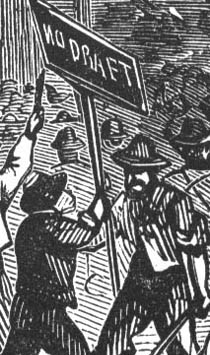|
Protesting
the draft |
In the decade preceding the war, a wave of immigrants came to New York, including many Irish fleeing the potato famine in their country. Westchester's population nearly doubled in that time. Competition for low-level jobs was fierce between recent immigrants and blacks. Thus, in New York City especially, the advent of the Civil War was a boon to poorer whites and free blacks as jobs were freed up by departing soldiers. (At that time, blacks were barred from enlisting, while recent immigrants had little motivation to do so.) New jobs were also created out of the need to supply industries that had once depended on Southern sources for products and material. The advent of conscription disrupted these tenuously peaceful race relations. Rioting began in New York City on Monday, July 13, 1863, when men burned the provost marshal's office, destroyed the list of draftees, cut telegraph wires, burned an orphan asylum for black children, and mobbed white soldiers and black civilians. (The Enrollment Act of March 3, 1863, established the Provost Marshal's Bureau of the War Department. Provost Marshals, located in congressional districts, had three duties: administer the National draft, encourage volunteer enlistment, and arrest deserters.) Thomas J. Byrne, the county enrolling officer at White Plains, was fired at but escaped unharmed.
|
